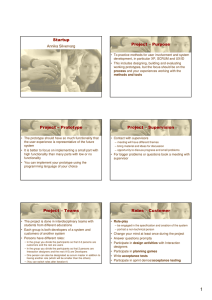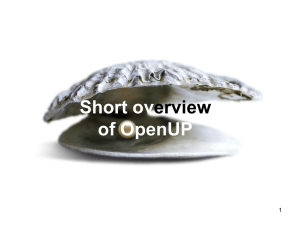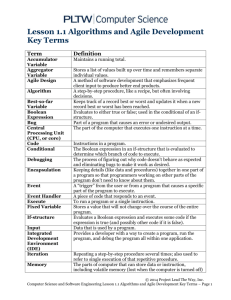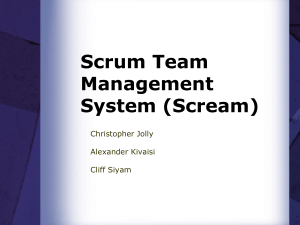Practical project planning in OpenUP
advertisement
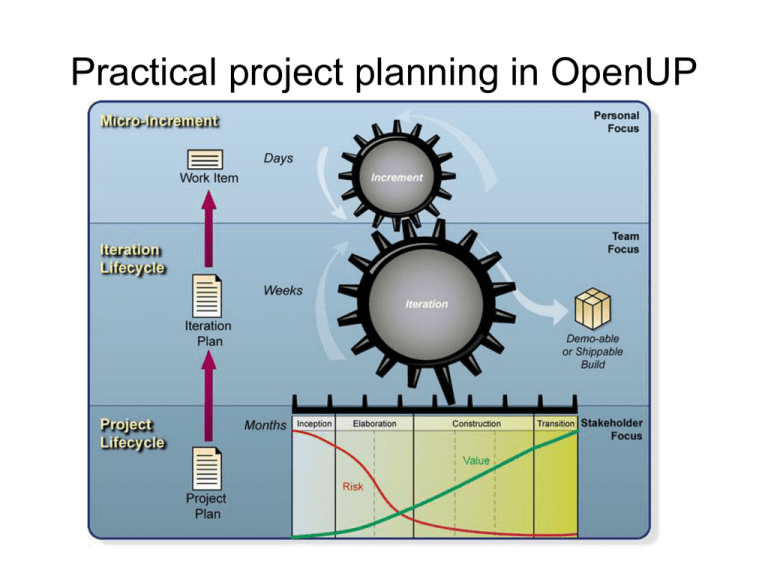
Practical project planning in OpenUP Sample Project plan content 1 2 Introduction Project organization Members, customers, roles, relations to other projects, work packages 3 Project practices and measurements OpenUP practices, time reporting, how to track progress 4 Project milestones and objectives High level goals per phase 5 Deployment How to ship, install and run the software 6 Lessons learned Notes for the experience report and continuous learning Additional things to plan • Meetings • Training • Quality assurance (own document): – Experience build-up – Change requests – Measurements – Reviews – Adapted processes What is a risk? Something that can eliminate full success of the project Examples: Staff turnover - Experienced team members will leave the project Requirement change - Significant requirements will change late in the process. Size underestimated - The size project was larger then expected Communication too slow – The communication between modules is too slow Realistic size of test data base not possible Kinds of risks General "A team member gets sick" "There is a risk that the project gets delayed" Direct The project has great control "The Windows platform will not scale" Project Specific "The delivery of the development hardware environment is delayed." "Anders needs to visit his family, since his father is dying." Indirect Risk where the project has little control "The servers will stop running due to an earthquake" What is risk management? Risk identification Risk analysis Risk planning Risk monitoring List of potential risks Prioritized list Risk plan Risk assessment "What can go wrong" "How bad is it" "What shall we do with it" "Has the probability changed?" 1. Risk Identification Brainstorming with the whole team for 10 minutes. What can go bad?!? Types of risks Technology risks Hardware/software technology used for development, e.g. using Java People risks people in the development team Organizational risks Tools risks Risks with the current tool used Requirements risks Changes in customer requirements Estimation risks Wrong project estimations 2. Risk Analysis catastrophic 4 Probability low 1 moderate 2 high 3 Probability x Impact = very high 4 serious 3 Impact tolerable 2 insignificant 1 Risk Magnitude Indicator Sort list after risk magnitude Manage no more than 20 risks Focus on technical risks 3. Risk Planning 1. Risk Avoidance Reorganize so that the risk disappears. 2. Risk Transfer Reorganize so that someone else takes the risk, insurance, customer, bank. 3. Risk Acceptance Live with it "Communication problem between develop sites in Stockholm and India - localize all development in India?" "the web-server fails often - low accessibility outsource the operation?" "Changes of requirements late in project - a prototype?" Mitigate the risk Lower the probability. "The key architect starts to work for another company - 2 architects?" Define Contingency plan A plan B... Iteration plan 1. Key milestones Mile-stones, synchronization 2. High-level objectives 3. Work Item assignments Reference or selection of Work Items List (next slide) 4. Issues 5. Evaluation criteria 6. Assessment (separate document?) Objectives, Work Items, Evaluation results, other deviations.. Work Items List • A central focus for the entire group • Both small, scheduled steps and large sub-projects • Each work-item has: – – – – – – – – – Name and Description Priority Size Estimate State References Target Iteration or Completion Date Assignee(s) Estimated Effort Remaining Hours Worked • Can be realised with other means Useful states • • • • • New Assigned Resolved Verified (by independent tester) Closed Size estimates • Classical hour estimation • Delphi method Expert Judgment - the Delphi technique [No change] Experts make individual predictions secretly Calculate Mean Mean is presented to expert group [An expert changes its estimate] Agile effort estimation • Points: A unit of a small piece of work • Can be translated to hours depending on person • Velocity: number of points per iteration by a team (= 1 Pum-group) • Plan and re-plan • Sustainable velocity How to manage a work items list Project burn-down Project Burndown Chart 60 50 Points 40 30 Release 20 10 0 1 2 3 4 5 6 7 Iterations Applies to iterations too. If you use time – use estimated time. 8 Relation to SCRUM OpenUP SCRUM • • • • • • • • • • • • • • • • • • • • • • • • Work Item list Iteration Iteration plan Project leader Customer Burn-down report Iteration assessment Self-organized team Defined phase milestones Roles No prescribed meetings S/W development guide Product Backlog Sprint Sprint backlog SCRUM master Product owner Burn-down chart Sprint retorspective Self-organized team No sprint mile-stones No roles Daily SCRUM Project management main focus

